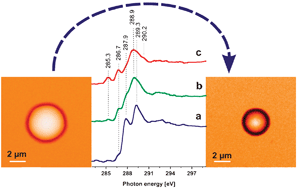Soft X-ray induced modifications of PVA-based microbubbles in aqueous environment: a microspectroscopy study
Abstract
We use scanning-transmission X-ray

* Corresponding authors
a
Friedrich-Alexander Universität Erlangen-Nürnberg, Department Chemie und Pharmazie, Egerlandstrasse 3, Erlangen, Germany
E-mail:
george.tzvetkov@psi.ch
Fax: +49-9131-85-28867
Tel: +49-9131-85-27321
b Swiss Light Source, Paul Scherrer Institut, Villigen – PSI, Switzerland
c Physikalische Chemie II, Universität Bayreuth, Universitätsstraße 10, Bayreuth, Germany
d Max Planck Institute for Colloids and Interfaces, Potsdam, Germany
e Dipartimento di Scienze e Tecnologie Chimiche, Università di Roma Tor Vergata, and CNR-INFM-SOFT, Via della Ricerca Scientifica, Roma, Italy
f Interdisciplinary Center for Molecular Materials (ICMM), Egerlandstrasse 3, Erlangen, Germany
We use scanning-transmission X-ray

 Please wait while we load your content...
Something went wrong. Try again?
Please wait while we load your content...
Something went wrong. Try again?
G. Tzvetkov, P. Fernandes, S. Wenzel, A. Fery, G. Paradossi and R. H. Fink, Phys. Chem. Chem. Phys., 2009, 11, 1098 DOI: 10.1039/B814946A
To request permission to reproduce material from this article, please go to the Copyright Clearance Center request page.
If you are an author contributing to an RSC publication, you do not need to request permission provided correct acknowledgement is given.
If you are the author of this article, you do not need to request permission to reproduce figures and diagrams provided correct acknowledgement is given. If you want to reproduce the whole article in a third-party publication (excluding your thesis/dissertation for which permission is not required) please go to the Copyright Clearance Center request page.
Read more about how to correctly acknowledge RSC content.
 Fetching data from CrossRef.
Fetching data from CrossRef.
This may take some time to load.
Loading related content
